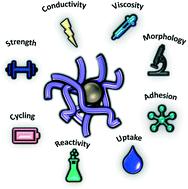当前位置:
X-MOL 学术
›
Mol. Syst. Des. Eng.
›
论文详情
Our official English website, www.x-mol.net, welcomes your
feedback! (Note: you will need to create a separate account there.)
Molecular design principles for polymeric binders in silicon anodes
Molecular Systems Design & Engineering ( IF 3.2 ) Pub Date : 2020-02-18 , DOI: 10.1039/c9me00162j Andrea Miranda 1, 2, 3, 4 , Kasturi Sarang 4, 5, 6, 7 , Bolormaa Gendensuren 8, 9, 10, 11 , Eun-Suok Oh 8, 9, 10, 11 , Jodie Lutkenhaus 4, 5, 6, 7, 12 , Rafael Verduzco 2, 3, 4, 13, 14
Molecular Systems Design & Engineering ( IF 3.2 ) Pub Date : 2020-02-18 , DOI: 10.1039/c9me00162j Andrea Miranda 1, 2, 3, 4 , Kasturi Sarang 4, 5, 6, 7 , Bolormaa Gendensuren 8, 9, 10, 11 , Eun-Suok Oh 8, 9, 10, 11 , Jodie Lutkenhaus 4, 5, 6, 7, 12 , Rafael Verduzco 2, 3, 4, 13, 14
Affiliation

|
Silicon anodes potentially offer a volumetric energy storage capacity significantly greater than that of commercial graphitic carbon anodes, but silicon electrodes exhibit poor stability under reversible charging and discharging. This has been attributed to several factors including large volume changes of silicon during battery operation, the non-passivating nature of the Si surface which can result in uncontrolled growth of solid-electrolyte interface layers, and reactivity between the binder and lithiated silicon. To address these challenges, researchers have developed innovative compositions and architectures of polymer binders aimed at increasing storage capacities and improving stability. Polymer binders serve multiple functions in battery electrodes including maintaining adhesion between the electrode and current collector and cohesion of the electrode as a whole, ensuring the stability of the solid electrolyte layer that forms on the surface of silicon, and in some cases providing electronic and ionic conductivity. The goal of this review is to identify and critically evaluate underlying molecular design principles applied to the development of polymeric binders for silicon anodes. Molecular design principles include molecular functionalities, architectures, or compositions that can produce a desired physical or chemical property. The review specifically focuses on the molecular features of binders that facilitate self-healing, electronic conductivity, mechanical performance, and electrochemical performance.
中文翻译:

硅阳极中聚合物粘合剂的分子设计原理
硅阳极潜在提供的体积储能能力明显大于商业石墨碳阳极,但硅电极在可逆充电和放电下显示出较差的稳定性。这归因于几个因素,包括电池操作过程中硅的大量变化,Si表面的非钝化性质(可导致固体电解质界面层不受控制的增长)以及粘合剂和锂化硅之间的反应性。为了应对这些挑战,研究人员开发了创新的聚合物粘合剂组合物和体系结构,旨在提高储存能力并提高稳定性。聚合物粘合剂在电池电极中具有多种功能,包括维持电极与集电器之间的粘合力以及整个电极的内聚力,确保形成在硅表面上的固体电解质层的稳定性,并在某些情况下提供电子和离子性电导率。这篇综述的目的是确定并严格评估应用于开发用于硅阳极的聚合物粘合剂的基本分子设计原理。分子设计原理包括可以产生所需物理或化学性质的分子功能,结构或组成。这篇综述特别侧重于促进自我修复,电子传导,机械性能和电化学性能的粘合剂的分子特征。
更新日期:2020-02-18
中文翻译:

硅阳极中聚合物粘合剂的分子设计原理
硅阳极潜在提供的体积储能能力明显大于商业石墨碳阳极,但硅电极在可逆充电和放电下显示出较差的稳定性。这归因于几个因素,包括电池操作过程中硅的大量变化,Si表面的非钝化性质(可导致固体电解质界面层不受控制的增长)以及粘合剂和锂化硅之间的反应性。为了应对这些挑战,研究人员开发了创新的聚合物粘合剂组合物和体系结构,旨在提高储存能力并提高稳定性。聚合物粘合剂在电池电极中具有多种功能,包括维持电极与集电器之间的粘合力以及整个电极的内聚力,确保形成在硅表面上的固体电解质层的稳定性,并在某些情况下提供电子和离子性电导率。这篇综述的目的是确定并严格评估应用于开发用于硅阳极的聚合物粘合剂的基本分子设计原理。分子设计原理包括可以产生所需物理或化学性质的分子功能,结构或组成。这篇综述特别侧重于促进自我修复,电子传导,机械性能和电化学性能的粘合剂的分子特征。











































 京公网安备 11010802027423号
京公网安备 11010802027423号